The 9-Step Morning Tune-Up for Strong, Healthy Gums
Do you rush through your dental care in the morning, viewing it as a brief two-minute diversion from your hectic day? You’re definitely not by yourself. The morning brush is often thought of as a straightforward breath freshener, but its actual function is much more important: it is your first and most important line of defence against gum disease, the silent aggressor.
Bacteria feasted on leftover food particles while you slept, growing quickly and creating the sticky substance known as plaque. Gingivitis, the early stage of gum disease, characterised by red, swollen, and bleeding gums, is caused by this plaque. Untreated gingivitis develops into periodontitis, which can cause bone loss and ultimately tooth loss, affecting everything from the appearance of your smile to your chewing ability.
The effective, proactive weapon you need to win this daily battle is your morning routine. You can significantly enhance your gum health, reduce inflammation, and protect your smile by implementing these nine smart, scientifically supported adjustments.
The Foundation, Brushing Technique, and Timing
1. Brush Before You Eat or Drink Coffee
The Crucial Timing Shift: After breakfast, stop brushing right away. Brush as soon as you wake up instead.
It’s a common mistake to put off brushing until after your morning meal, particularly if it contains acidic foods like fruit, coffee, or orange juice. Your tooth enamel becomes temporarily softer and more vulnerable when you consume acidic foods and drinks. You are literally scrubbing away tiny layers of softened enamel if you brush your teeth right after eating.
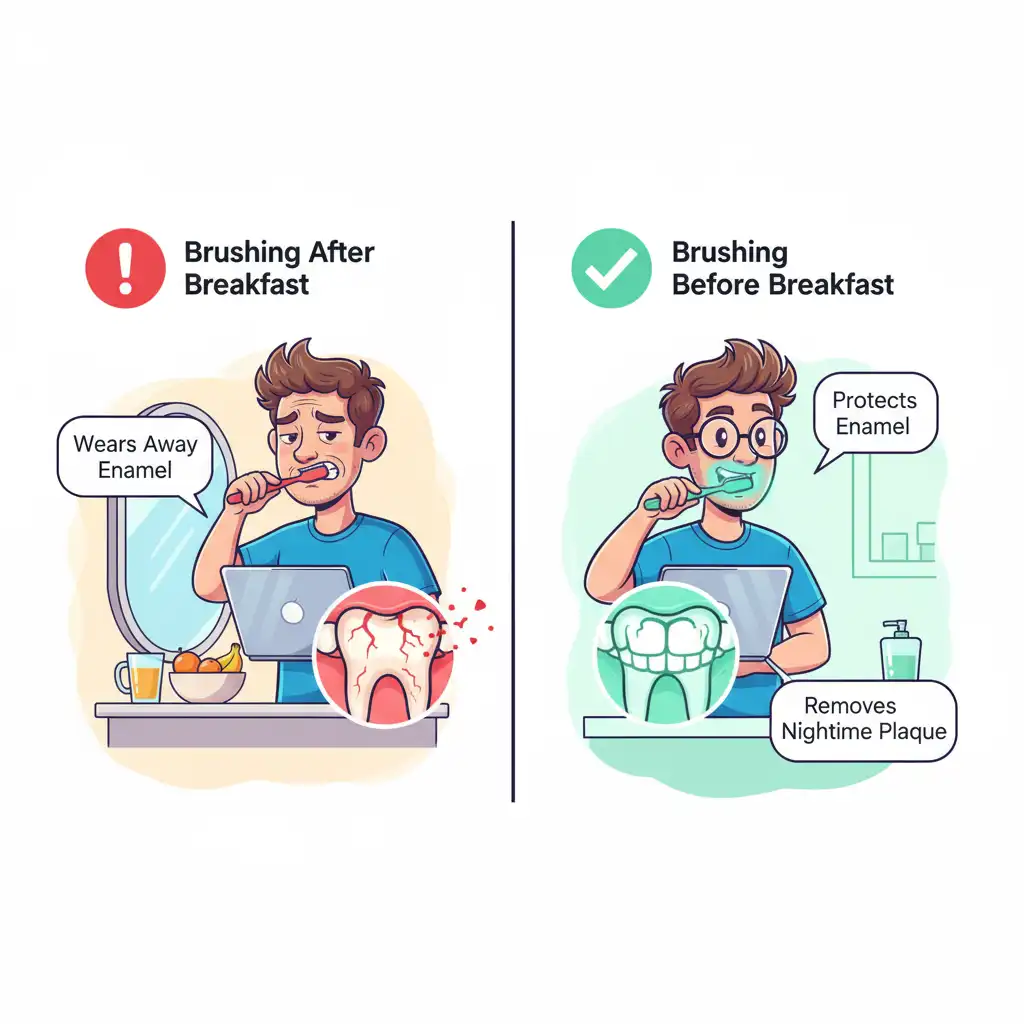
Why This Benefits Your Gums: Brushing first helps to clear your gum line of the accumulation of bacteria and plaque that has accumulated over the course of the night. More significantly, before your enamel is exposed to acids, the fluoride in your toothpaste coats and fortifies it. By brushing regularly, you can prevent tooth erosion and reduce the amount of time plaque irritates your gums. Additionally, a clean mouth improves the effectiveness of any further flossing or rinsing.
2. Ditch the Hard Bristles and Go Soft
The Tool Upgrade: Replace any medium- or hard-bristled toothbrush with a high-quality electric toothbrush or one with soft bristles.
Many patients think that using harder bristles or brushing more vigorously results in cleaner teeth. In actuality, one of the main causes of gum recession is vigorous brushing, also referred to as “toothbrush abrasion.” The sensitive gum tissue and enamel close to the gum line are physically eroded over time by those hard bristles.
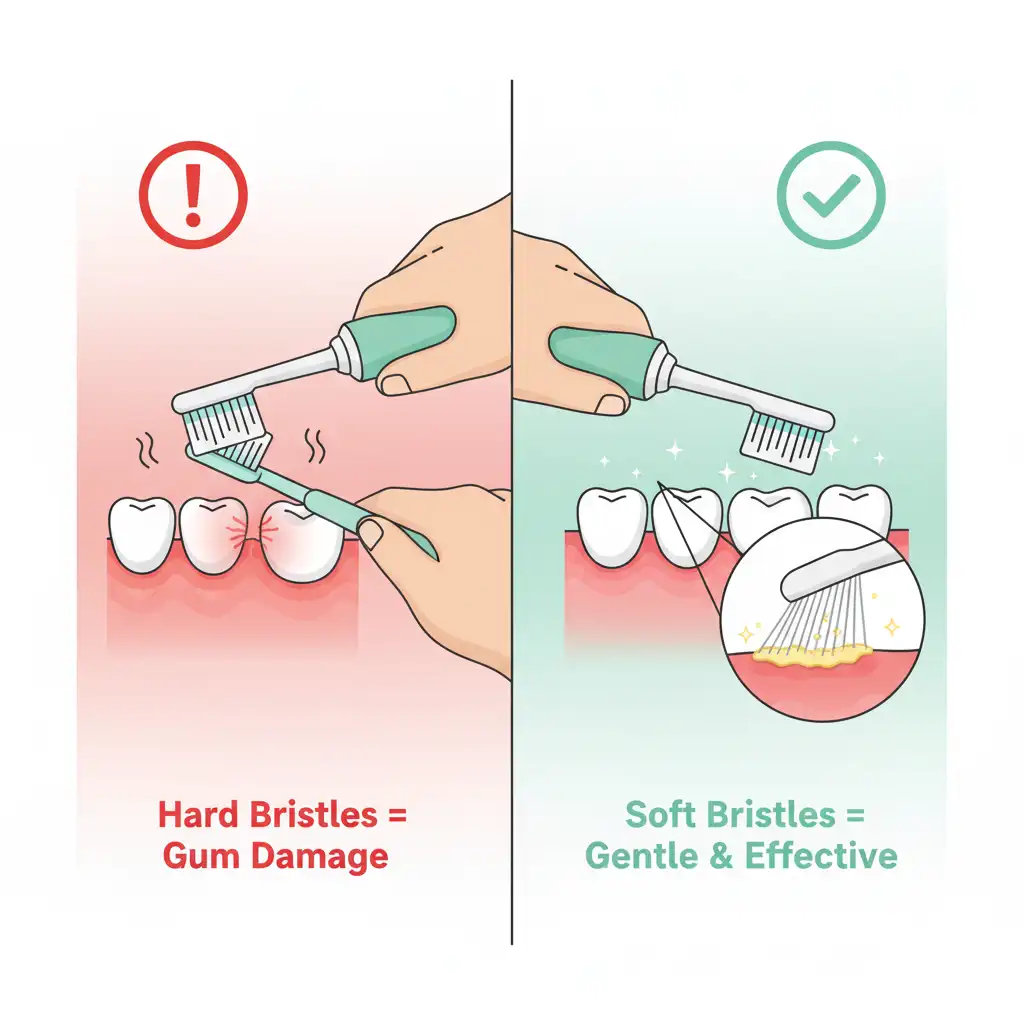
Why Your Gums Benefit from This: Plaque can be broken up and removed without causing physical harm by using soft bristles or the delicate, controlled motions of an electric toothbrush. Gentle, comprehensive plaque removal is the aim, not abrasion.
The severity of this easy error is highlighted by the fact that if you have already experienced gum recession as a result of vigorous brushing, you might need to consult a specialist regarding possible tissue grafts to replace lost gum structure. Replace the head of your toothbrush every three to four months, or sooner if the bristles seem frayed.
3. Master the 45∘ Brushing Angle
The Precision Technique: Put an end to brushing your teeth directly. Rather, tilt the bristles 45 degrees in the direction of the gum line.
Most people only clean the outside of their teeth with a brush held perpendicular to their teeth. The sulcus, or tiny pocket between the tooth and the gum, is the most important location for gum health and is entirely overlooked by this technique.
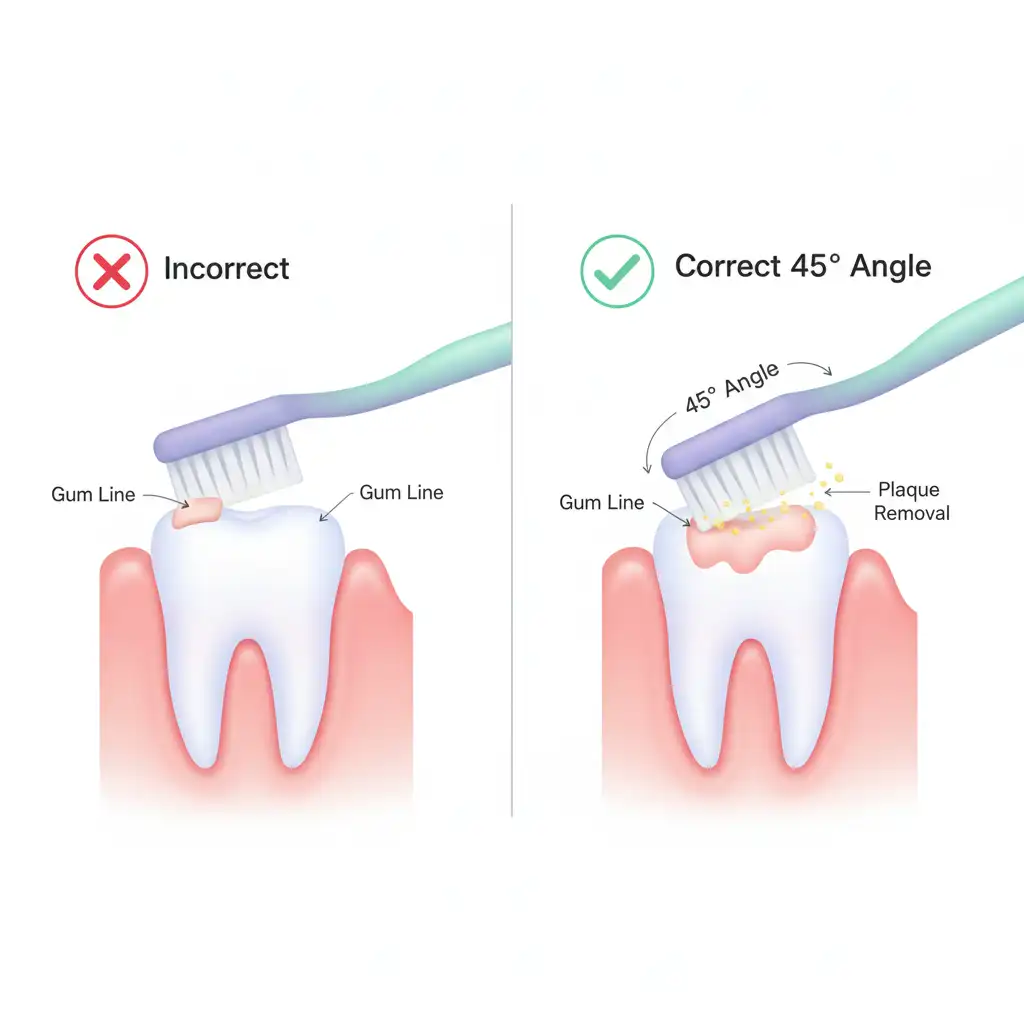
Why Your Gums Benefit from This: The gum-tooth margin is where plaque naturally gathers and solidifies into tartar, and this 45° angle, often referred to as the Bass technique, allows the soft bristles to gently penetrate and clean it. Instead of using a rough back-and-forth sawing motion, use tiny, delicate, circular, or vibrating strokes.
The plaque irritants are physically removed by this gentle sweeping motion before they have a chance to cause inflammation and the early stages of gum disease. Ask your hygienist for a dental cleaning step-by-step demonstration of this technique.
4. Time Yourself for a Full Two Minutes
The Time Commitment: Use a timer for a full 120 seconds and never guess.
Brushing takes less than 60 seconds on average. Many parts are totally overlooked in the morning rush, especially the chewing surfaces of the back molars close to the gum line and the inner surfaces of the front teeth.
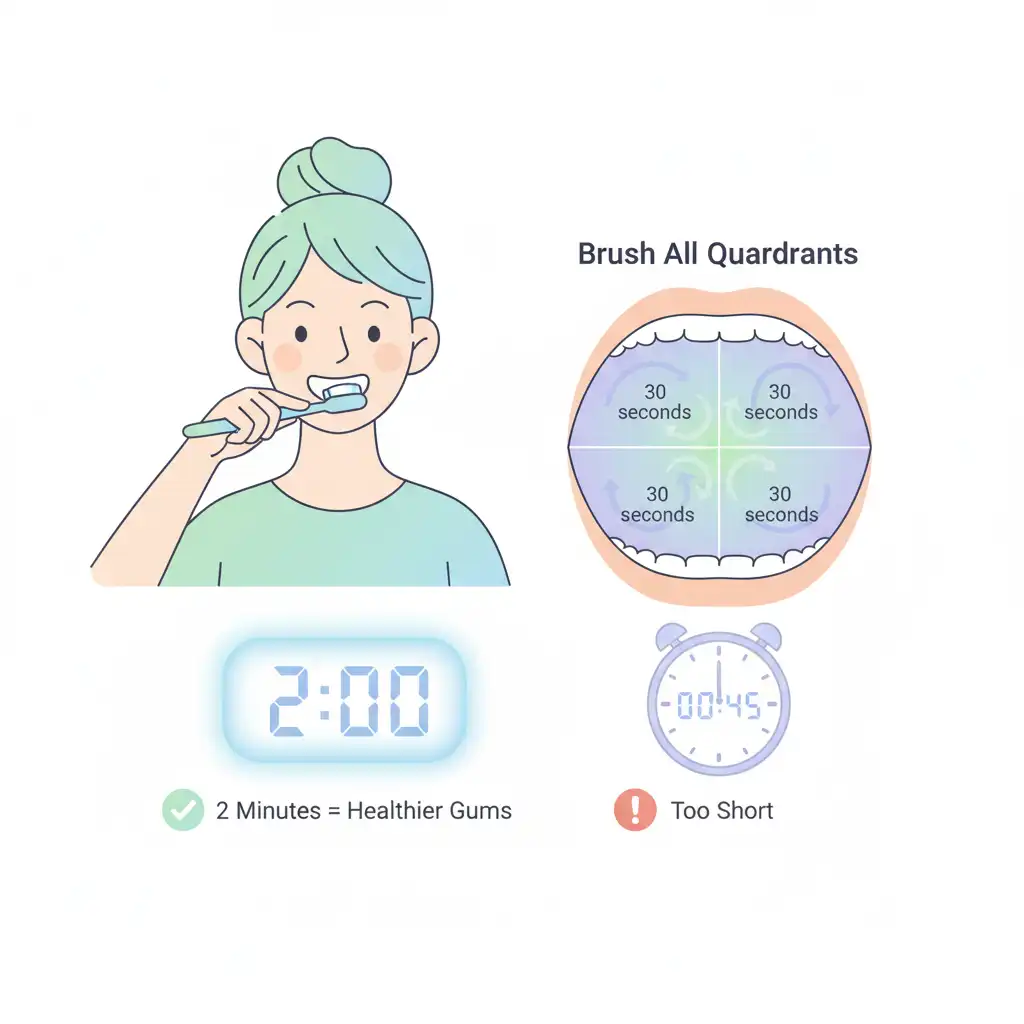
Why Your Gums Benefit from This: You will have enough time to spend roughly 30 seconds on each of the four quadrants of your mouth (upper left, upper right, lower left, and lower right) if you commit to two minutes.
Brushing at regular intervals ensures that all tooth surfaces are completely free of plaque, avoiding localised accumulation that exacerbates gum inflammation. The foundation of good oral health and the relationship between dental health and general health is this practice.
The Advanced Clean, Beyond the Brush
5. Floss as a Standalone Step (The "C" Shape)
The Critical Interdental Clean: Make flossing a conscious and intentional part of your daily routine.
Despite being the most important step for gum health, flossing is the oral hygiene procedure that is most frequently neglected. Toothbrushes are unable to efficiently clean below the gum line or reach the tiny spaces between teeth.
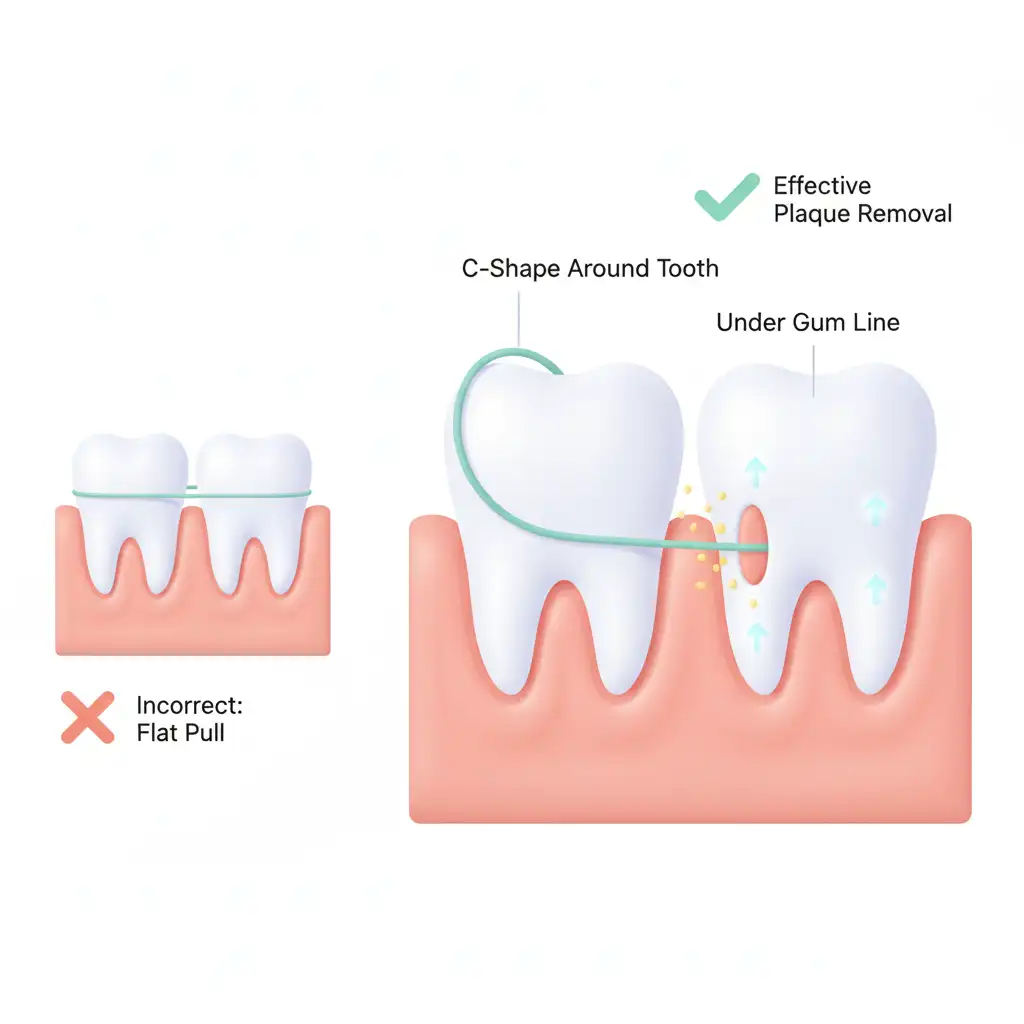
Why This Benefits Your Gums: During the process of cleaning or scaling, plaque between teeth can rapidly solidify into tartar, or calculus, which can only be eliminated by a dentist. For the floss to be effective, it must be curved into a ‘C’ shape around the base of one tooth, carefully slid under the gum line, and scraped upward. Then, you must repeat the ‘C’ shape on the neighbouring tooth.
By physically scraping plaque off the root surface, this action stops periodontal disease from developing in the most common place. Try using floss picks or interdental brushes if you have trouble flossing.
6. Add a Dedicated Tongue Scrape
The Bacterial Purge: Clean the tongue surface from back to front using a specialised tongue scraper.
The surface of the tongue is covered in papillae, which resemble microscopic shag carpets and trap dead cells, food particles, and bacteria to form a white or yellow coating.
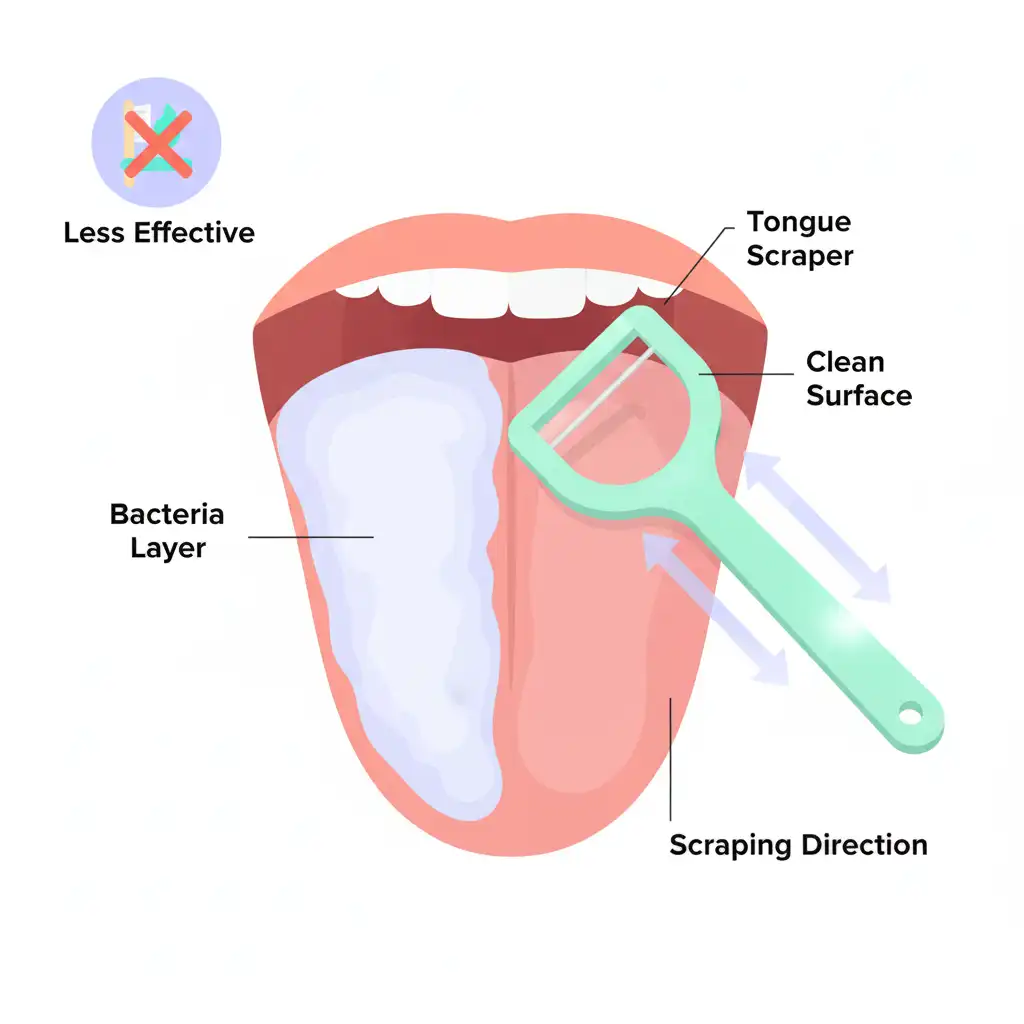
Why This Benefits Your Gums: The accumulation of this material creates a reservoir of dangerous bacteria that are easily spread to your teeth and gums, causing plaque to form and persistent inflammation.
A tongue scraper’s design pulls the film away without forcing it further into the papillae, making it far more effective than a toothbrush. Additionally, this greatly improves breath freshness and promotes a healthier oral environment in general.
7. Hydrate with Plain Water Immediately
The Saliva Stimulus: Immediately following your cleaning routine, start your day with a large glass of clean, plain water.
Due to decreased salivary flow during the night, many people wake up with dry mouth, which can be made worse if they have dry mouth causes and natural remedies. Your mouth’s natural defence mechanism and detergent is saliva.
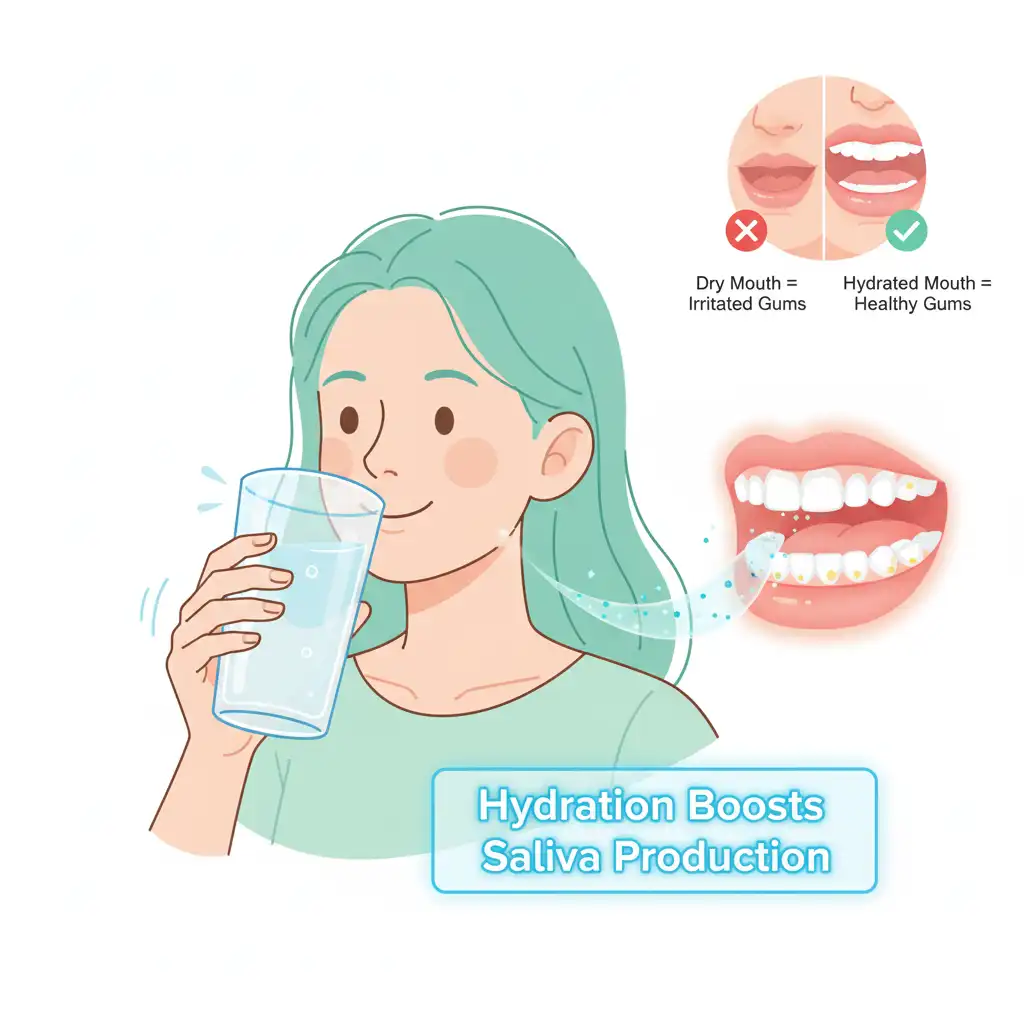
Why This Benefits Your Gums: Saliva contains vital minerals (phosphate and calcium) that aid in the repair of microdamage to gum tissue and enamel, as well as naturally washing away food particles and neutralising the acids produced by plaque.
Water intake instantly increases saliva production, which is essential for minimising gum irritation and preventing plaque from adhering. Another crucial aspect of dental implant care is maintaining proper hydration, which supports oral tissue health and healing.
8. Incorporate a Water Flosser or Oral Rinse (Timing is Key)
The Power Boost: Never use a water flosser or a mouthwash right after brushing.
The concentrated fluoride layer that your toothpaste just applied is removed when you use an alcohol-based mouthwash immediately after brushing. This negates one of brushing’s main protective advantages.
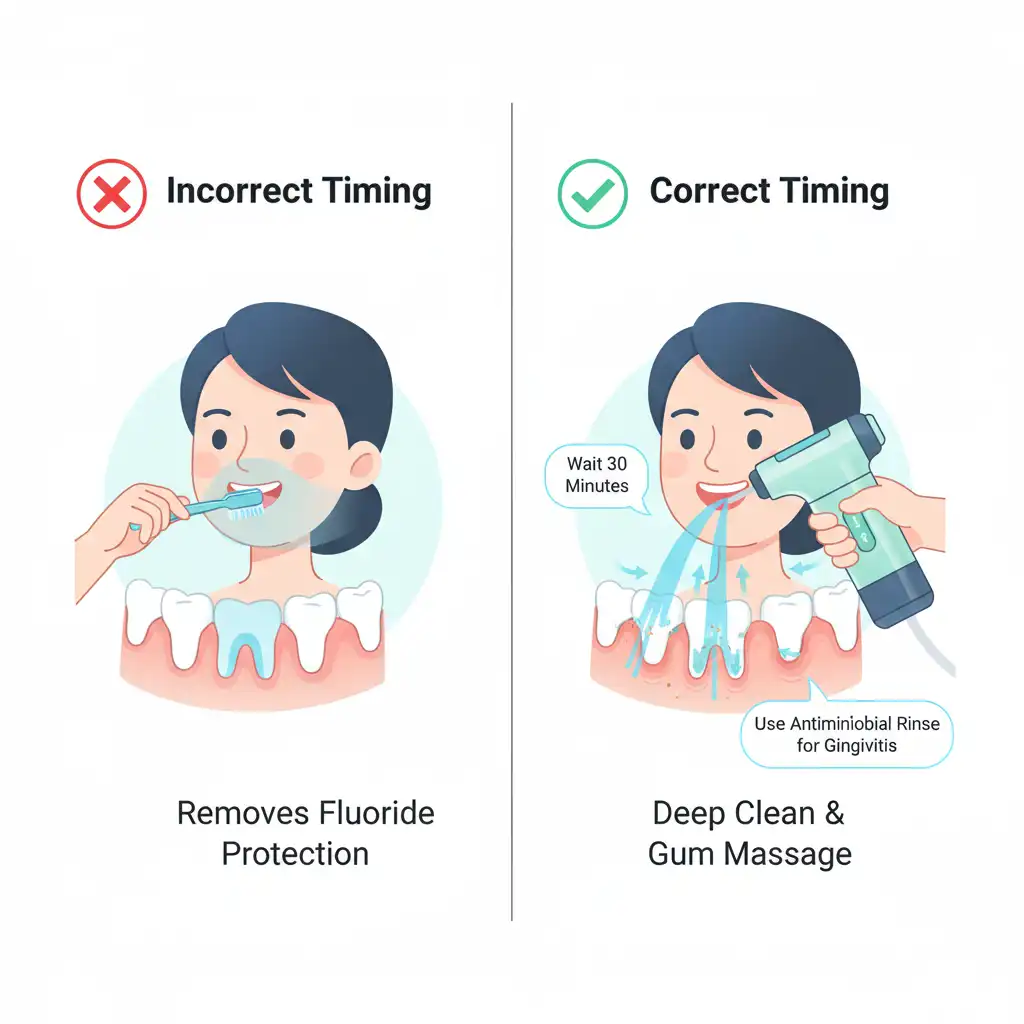
Why This Benefits Your Gums: The water flosser is a strong tool that can remove debris from difficult-to-reach places. It also functions as a deep gum massage and cleaning tool and is a great defence against bacteria that live in the deep pockets. It is frequently used in conjunction with a deep cleaning.
Wait at least half an hour after brushing if you plan to use mouthwash. To help manage the bacteria that cause gingivitis, use a therapeutic or antimicrobial rinse. Extra protection is offered by this extra layer of antibacterial defence, particularly if you already have gum recession or are prone to inflammation.
9. Wait 30 Minutes to Brush After Acidic Intake
The Enamel Safety Gap: Rinse with water and wait at least half an hour before picking up your toothbrush if you must consume acidic foods or beverages (such as vinegar or citrus) before brushing.
This rule applies to situations where the order becomes confused and is a direct extension of Change #1.
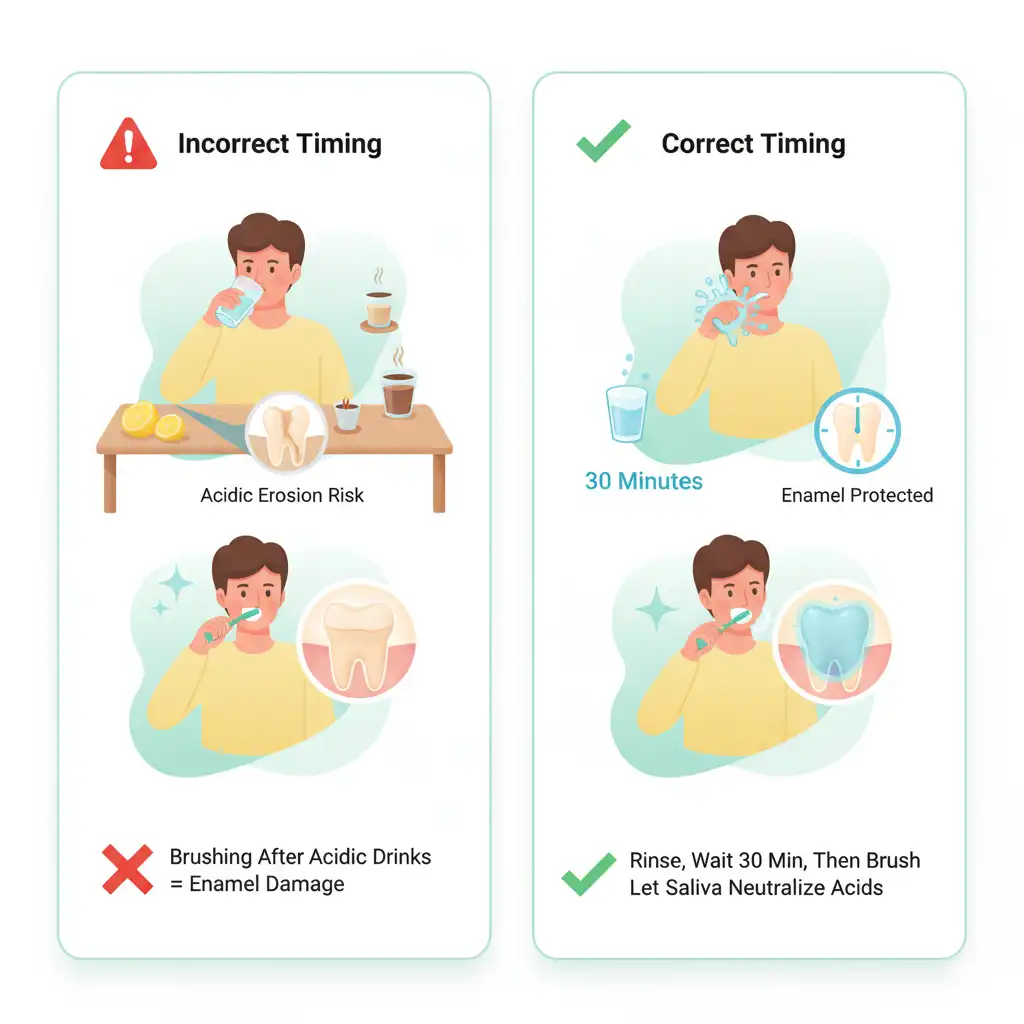
naturally neutralise the acids and initiate the enamel’s remineralisation process. It is extremely harmful to brush during this vulnerable time.
Protecting your enamel from abrasion is crucial if you want a flawless smile, which may involve procedures like porcelain veneers or teeth whitening. Enamel integrity and gum health are closely related.
Pro-Tips for Gum Longevity and Aesthetics
For those dedicated to maximizing their gum and smile health, consider these advanced strategies:
- Clean Dental Appliances: If you use a Night Guard, Fixed Wire Retainer, or Invisalign trays, make cleaning them a morning priority. Appliances can harbor bacteria that are then constantly in contact with your gums.
- Consider Advanced Screenings: Discuss Laser Pocket Disinfection with your dental professional. This simple, non-surgical laser treatment can target and reduce the bacterial load in the gum pockets, offering a boost to your hygiene efforts.
- Smile Aesthetics: Your gums frame your teeth. If you have excess gum tissue, a gummy smile, a dental professional can discuss options for gum contouring, which falls under the umbrella of a full smile makeover treatment. Healthy, properly contoured gums are the foundation of any brilliant aesthetic result.
When to Seek Professional Help
While a superior morning routine is essential, it is not a substitute for professional care. You should schedule a comprehensive Oral Exam and cleaning every six months.
- Telltale Signs: If your gums continue to bleed despite consistent flossing, if you notice chronic bad breath, or if you feel any teeth becoming slightly loose, these are all gum disease warning signs and treatment signals.
- Professional Cleaning: Even the best brushing and flossing can’t remove tartar, the hardened calculus that forms below the gumline. Regular professional cleaning is required to remove this and prevent the progression to advanced periodontitis.
Conclusion
By implementing these nine tactical adjustments, you are investing in a future of improved health, cleaner breath, and a more self-assured smile. Your morning routine sets the tone for your day. Consistency, not complexity, is needed.
Prioritise cleaning the gumline before rushing to get your coffee, pay attention to the 45° angle, and dedicate the two minutes. Your smile is built on your gums, so give them the attention and care they need.
FAQs
1. How can I get healthy gums in the morning?
Start by brushing before breakfast, using a soft-bristled toothbrush, and following the 45° brushing technique. Add flossing, tongue scraping, and hydration to your morning routine for strong, healthy gums.
2. Why should I brush before breakfast instead of after?
Brushing before breakfast removes bacteria that built up overnight and protects enamel with fluoride before acidic foods or drinks can soften it.
3. What type of toothbrush is best for gum health?
Use a soft-bristled or electric toothbrush. Hard bristles can cause gum recession and enamel wear, while soft ones clean effectively without irritation.
4. How long should I brush my teeth for healthy gums?
Brush for a full two minutes, 30 seconds per mouth quadrant, to ensure plaque removal from all areas, especially near the gum line.
5. Is flossing really necessary if I brush well?
Yes. Flossing removes plaque and debris from between teeth and below the gum line, where brushing can’t reach, essential for preventing gum disease.

Dr. Alexander Heifitz (Author)
Dr. Alexander Heifitz is the founder of 65 Broadway Dental in NYC, where he combines advanced dental expertise with a patient-first approach. He specializes in cosmetic and restorative treatments such as dental implants, veneers, Invisalign, and smile makeovers, helping New Yorkers achieve both oral health and confidence.
Booking An Appointment
Looking for a reliable dentist in Downtown NYC? Whether you need a routine cleaning, urgent care, or a full smile transformation — we’ve got you covered. We accept most PPO insurance plans and offer flexible scheduling.
+1 (212) 430-3888
Call for appointment
Walk-ins Welcome / Same-Day Appointments Available

Related Blogs
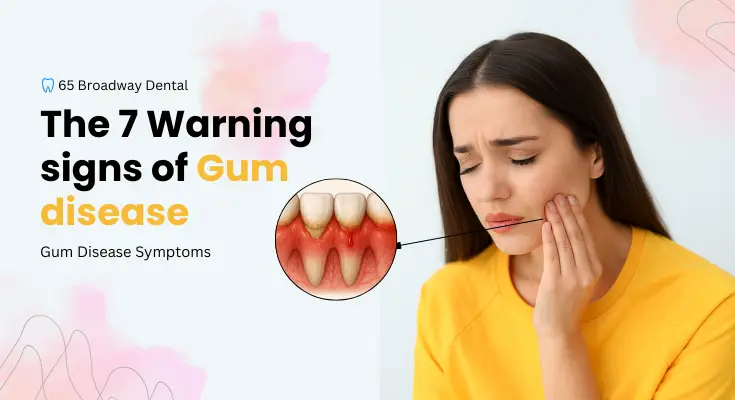
Gum Disease Warning Signs | Treatment & Causes
Discover gum disease warning signs, causes, and treatments. Learn how to spot early symptoms and protect your oral health with the right care.
Read More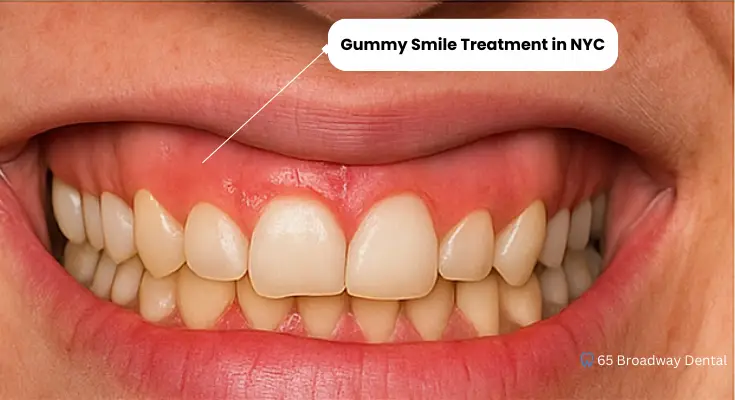
Gummy Smile Treatment in NYC: Options That Work
Discover effective gummy smile treatments in NYC. Learn about options like Botox, veneers, and surgery to enhance your smile and boost confidence.
Read More